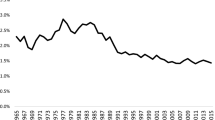Abstract
The military alliance between South Korea and the USA is examined in the context of the North Korean threat. The findings are as follows: First, South Korea is more sensitive to the North Korean threat than the USA. Second, defense goods are affected more by national income and own price than by the North Korean threat. Third, the spill-in elasticity of demand for defense goods in South Korea is increasing in absolute value. The policy implications are that South Korea needs to strengthen the military alliance with the USA and to put emphasis on national income growth in defense budget planning.
Similar content being viewed by others
References
Ahn Y (1995) A study on optimal military expenditures and efficient allocation (in Korean). Hwarangdae Institute, Seoul
Ahn Y, Chun S (1998) A study on the allocation of military expenditures between South Korea and the United States (in Korean). Hwarangdae Institute, Seoul
Conybeare JAC, Sandler T (1990) The triple entente and the alliance 1880–1914: a collective goods approach. Am Polit Sci Rev 84: 197–206
Friz-Assmus D, Zimmermann K (1990) West German demand for defense spending. In: Hartly K, Sandler T(eds) The economics of defence spending. Routledge, London, pp 118–147
Gonzales RA, Mehay SL (1991) Burden sharing in the NATO alliance: an empirical test of alternative views. Public Choice 68: 107–116
Hilton B, Vu A (1991) The McGuire model and the economics of the NATO alliance. Defense Econ 2: 105–121
Looney RE, Mehay SL (1990) United States defence expenditures: trends and analysis. In: Hartly K, Sandler T(eds) The economics of defence spending. Routledge, London, pp 13–40
McGuire MC (1982) US assistance, Israeli allocation, and the arms race in the Middle East. J Confl Resolut 26: 199–235
Murdoch JC, Sandler T (1982) A theoretical and empirical analysis of NATO. J Confl Resolut 26: 237–263
Murdoch JC, Sandler T (1984) Complimentarily, free riding, and the military expenditure of NATO allies. J Public Econ 25: 83–101
Murdoch JC, Sandler T (1985) Australian demand for military expenditure: 1961–1979. Aust Econ Papers 44: 142–153
Murdoch JC, Sandler T (1986) The political economy of Scandinavian neutrality. Scand J Econ 88: 583–603
Murdoch JC, Sandler T (1990) Swedish military expenditures and armed neutrality. In: Hartly K, Sandler T(eds) The economics of defence spending. Routledge, London, pp 148–176
Okamura M (1991) Estimating the impact of the Soviet Union’s threat on the United States-Japan alliance: A demand system approach. Rev Econ Stat 73: 200–207
Olson M, Zeckhauser R (1966) An economic theory of alliances. Rev Econ Stat 48: 266–279
Oneal JR (1990) Testing the theory of collective action: NATO defense burdens, 1950–1984L. J Confl Resolut 34: 426–448
Pollak RA, Wales TJ (1980) Comparison of the quadratic expenditure system and translog demand systems with alternative specifications of demographic effects. Econometrica 48: 595–612
Palmer G (1990a) Alliance politics and issue areas: determinants of defense spending. Am J Polit Sci 34: 190–211
Palmer G (1990b) Corralling the free rider: deterrence and the western alliance. Int Stud Quart 34: 147–164
Sandler T (1977) Impurity of defense: an application to the economics of alliances. Kyklos 30: 443–460
Sandler T, Cauley J (1975) On the economic theory of alliance. J Confl Resolut 19: 330–348
Sandler T, Forbes JF (1980) Burden sharing, strategy, and the design of NATO. Econ Inquiry 18: 425–444
Sandler T, Murdoch JC (1990) Nash-Cournot or Lindahl behavior?: an empirical test for the NATO Allies. Quart J Econ 105: 875–894
Smith R (1980) The demand for military expenditure. Econ J 90: 811–820
Smith R (1987) The demand for military expenditure: a correction. Econ J 97: 989–990
Smith R (1989) Models of military expenditure. J Appl Econ 4: 345–359
Smith R (1990) Defence spending in the United Kingdom. In: Hartly K, Sandler T(eds) The economics of defence spending. Routledge, London, pp 76–92
Author information
Authors and Affiliations
Corresponding author
Additional information
We would like to thank two anonymous referees for their helpful comments. This research was supported by Korea National Defense University and Hankuk University of Foreign Studies Research Fund.
Rights and permissions
About this article
Cite this article
Goo, YW., Kim, SN. A study on the military alliance of South Korea–United States with the existence of threat from North Korea: a public good demand approach. Empir Econ 36, 597–610 (2009). https://doi.org/10.1007/s00181-008-0213-2
Received:
Accepted:
Published:
Issue Date:
DOI: https://doi.org/10.1007/s00181-008-0213-2




